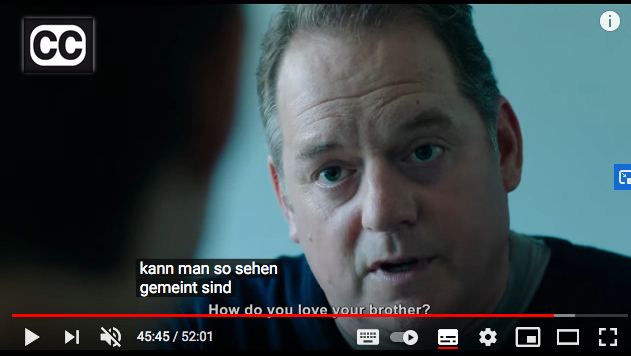
Lead-in burned-in English subtitles and automatic German live translation of the original French audio (audio unclear: “Comment s’y …” or “Comment se …” = ‘can you …’) cc Meme from screenshot of the opening video of Filmfest Braunschweig (excerpt: trailer for “Antigone” by Sophie Deraspe).
The creation of subtitles in online videos are a requirement for accessibility and the first step for translations into other languages. As festivals currently cannot be held in cinemas and films are streamed online instead, there is an increased need for subtitled versions. While subtitles are usually ‘burned in’ for cinema copies or included as multilingual version files in DCPs, which requires expensive programs, other solutions are now needed.
Fortunately, for subtitling online videos, there are free applications with versatile capabilities. Such tools can also take advantage of online streaming, namely the playback of subtitles as so-called closed captions (cc), which are selectable in multiple languages.
For non-professional purposes, YouTube’s subtitling tool may be sufficient[1], but those who want to publish on other platforms or don’t want to subscribe to Google/YouTube will have to search elsewhere. Especially also if you don’t want to embarrass yourself with automatically, mostly incorrectly, created foreign language subtitles. There are good free solutions for this, both as a standalone program or as an online application.
One of the oldest and most versatile free applications is Aegisub[2]. It is a desktop editor for local editing, available for many operating systems.
Originating from the anime fan scene, Aegisub masters a variety of useful features. These include perfect timing control, convenient correction options and export to all popular subtitle file formats. The voice assistant is also useful. Unusual for subtitling programs is the Styling Assistant, which allows versatile typographic styling of the font.
A good online alternative that can be used to do captioning in the browser window is Amara[2]. The non-profit Participatory Culture Foundation is behind the application, which has also proven itself over a long period of time and is constantly being developed further. PCF is supported by the European Commission, Mozilla and the MacArthur Foundation, among others.
Amara specializes in creating foreign-language versions of subtitle texts once they have been transcribed. The only requirement is that the video is first uploaded to Amara. For editing, editing windows open below the time-controlled video image, allowing two languages to be edited side-by-side. This is useful because text lengths can be very different in different languages. The finished subtitles can be exported in many formats. Also, direct import to YouTube and Vimeo is supported.
Amara handles more languages than any other subtitling application, in fact, more than 100 languages. What makes Amara special, however, is the help it receives from a large polyglot community. In keeping with the platform’s participatory philosophy, people upload their videos and pitch them out for collective translation. Even reviews and revisions by the international community are possible. For higher demands and non-public services, Amara also offers graduated pricing models, depending on the service.
More applications (link):
More applications can be found on this overview of Netzwelt magazine: Create and edit subtitles (in German)
[1] Instructions for YouTube Studio
1 Trackback